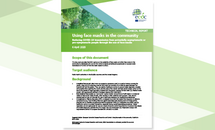Considerations for the use of face masks in the community in the context of the SARS-CoV-2 Omicron variant of concern
This document provides an update to and complements the ECDC technical report on “Using face masks in the community: first update - Effectiveness in reducing transmission of COVID-19” published on 15 February 2021. The aim was to review whether the scientific evidence basis has changed since December 2020 and whether any changes are warranted given the emerging evidence on variants of concern (VOCs) and particularly the Omicron VOC. This document therefore builds on the evidence available in the literature and presents recommendations for public health measures. The use of face masks by healthcare workers for the prevention of COVID-19 is out of the scope of this document and is covered in the latest update to the technical report ‘Infection prevention and control and preparedness for COVID-19 in healthcare settings’, published on 9 February 2021.
Executive Summary
Key messages
- A public health policy for wearing a face mask in public spaces should be considered in areas with community transmission when the public health objective is to limit community transmission. An additional option is to focus on the use of face masks in specific settings to protect people vulnerable to severe COVID-19, such as the elderly and people with underlying medical conditions.
- The appropriate use of face masks is important. The face mask should completely cover the face from the bridge of the nose down to the chin. The mask should be correctly adjusted on the bridge of the nose and to the face to minimise open space between the face and the mask.
- When community face coverings are used, it is advisable to choose coverings that comply with available standards for filtration efficacy and breathability, e.g. CEN CWA 17553.
- Respirators are expected to be more effective than medical masks, while community face coverings not manufactured according to the specifications in available guidelines for filtration efficacy and breathability are expected to be less effective than medical face masks. Selecting the type of face mask should take into account access, availability and tolerability, in addition to effectiveness.
Download






